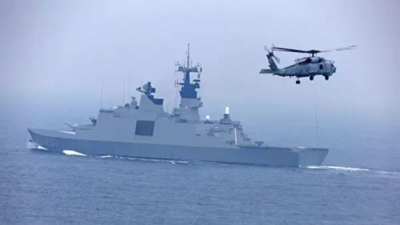Taiwan’s ministry of national defence (MND) reported a surge in Chinese military activity around the island, with 41 aircraft, nine People’s Liberation Army Navy (PLAN) vessels, and one official Chinese ship detected operating in the region.
The activity was recorded up until 6 am (UTC+8) on Monday, the ministry stated in a post on X.
Of the 41 Chinese aircraft, 28 crossed the median line of the Taiwan Strait and entered Taiwan’s northern, central, and southwestern Air Defence Identification Zone (ADIZ), the MND confirmed.
“We have monitored the situation and responded accordingly,” the statement read.
This increase in Chinese military presence comes amid heightened tensions in the Taiwan Strait, following the recent transit of two US naval ships through the contested waterway.
According to a statement from China’s foreign ministry, Beijing reiterated its stance that Taiwan is an inalienable part of its territory and criticised any actions that it perceives as threats to its sovereignty.
“The Taiwan question has nothing to do with freedom of navigation but bears on China’s sovereignty and territorial integrity,” foreign ministry spokesperson Guo Jiakun said in a press conference.
“China firmly opposes any country challenging or threatening China’s sovereignty and security under the pretext of freedom of navigation”, Jiakun added.
Canada joins US in strait transits
Meanwhile, Taiwan’s MND reported that a Canadian frigate transited through the Taiwan Strait on Sunday, marking the first such passage by Canada in 2025. The Halifax-class frigate HMCS Ottawa travelled from south to north, with Taiwan closely monitoring the surrounding airspace and waters.
Taiwan’s ministry of foreign affairs (MOFA) stated that the transit demonstrated Canada’s commitment to maintaining peace and stability in the region. “The Royal Canadian Navy’s actions reflect Canada’s support for a free and open Indo-Pacific,” the ministry said, as reported by the Central News Agency (CNA).
Beijing, however, criticised Canada’s transit, with the Chinese military stating that such actions “deliberately stir up trouble and undermine peace and stability across the Taiwan Strait.” The Eastern Theatre Command of the People’s Liberation Army (PLA) said it deployed naval and air forces to monitor the passage. “We will resolutely counter all threats and provocations,” a PLA spokesperson, told AFP.
The rise in Chinese military activity coincides with increasing international discussions on Taiwan’s security. Recently, US secretary of state Marco Rubio, along with Japanese foreign minister Iwaya Takeshi and South Korean foreign minister Cho Tae-yul, reaffirmed their commitment to maintaining stability in the Taiwan Strait.
“The Taiwan Strait’s security is a global consensus,” Taiwan’s foreign minister Lin Chia-lung stated in a post on X. He thanked his counterparts for supporting Taiwan’s international participation and regional stability.
A joint statement released by the White House following a trilateral meeting between the US, Japan, and South Korea in Munich also underscored the importance of peace in the region.
“They emphasised their opposition to any unilateral attempts to change the status quo by force or coercion and expressed support for Taiwan’s meaningful participation in international organisations”, the statement said.
China has recently ramped up its capacity for amphibious assaults on Taiwan, enhancing its naval forces with advanced landing helicopter assault (LHA) vessels and the mass production of floating bridge docks. These developments are seen as part of Beijing’s broader strategy to increase pressure on Taiwan.
The Taiwan-China conflict remains a longstanding geopolitical issue, with Taiwan functioning as a self-governing entity despite China’s claims over the island. Beijing has continued to apply diplomatic, economic, and military pressure on Taiwan, which maintains strong domestic and international support for its sovereignty.







